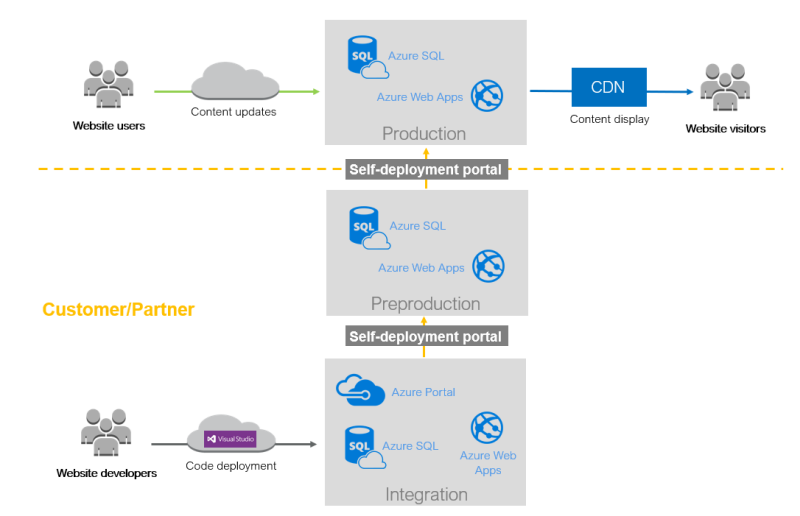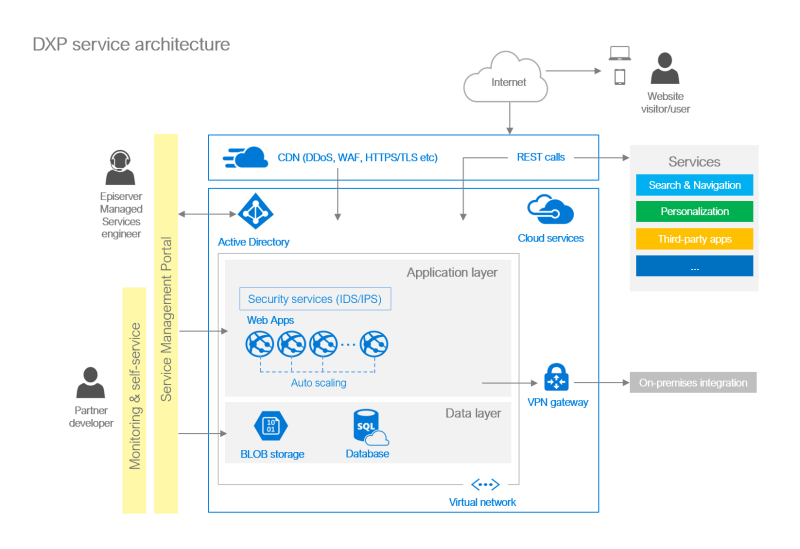Optimizely DXP cloud services vs. your own infrastructure: key benefits and considerations
July 3, 2024 / 7 min read

Table of contents
- Do you have existing infrastructure and a team to manage it?
- Do you want to strategically outsource responsibility for critical features?
- Are you starting a new project or do you already have an Optimizely solution?
- Do you want to control performance aspects like autoscaling and CDN?
- Do you have high security requirements?
- Do you have the expertise to ensure stability, monitoring and 24/7 support for the infrastructure?
- What’s included in Optimizely DXP?
- Summary
This guide will provide you with what to consider when choosing between Optimizely DXP Cloud Services and managing your own infrastructure. It's not a binary choice; each option has merits based on your needs.
Deciding whether to go with a Optimizely DXP services or a own cloud subscription is a real head-scratcher. This article explores the key considerations to help you make the right choice for your specific situation. We tried to cover all the important points, but if you think we have missed something, get in touch.
Do you have existing infrastructure and a team to manage it?
If yes: You may reduce costs by implementing and maintaining your own infrastructure. This is great, you are likely already running the best solutions to your organisation’s needs. However, if you are still considering adopting Optimizely DxP in your next project, here are what you need to consider:
DXP Cons:
- Learning curve: DXP requires learning new workflows, tools, and best practices.
DXP Pros:
- Out-of-the-box infrastructure: Includes App Services, SQL Server, Storage Accounts, App Insights, CDN, Monitoring, Security Center, DdoS protection, WAF, Azure Key Vault, Backup Services, networking, and load balancing.
- Out-of-the-box functionality to promote new app versions from integration to preproduction to production environment.
- Simplified CI/CD setup: Dedicated portal for migrating new site versions between environments.
- PaaS Portal: Optimizely custom portal to manage deployments, content transfers between environments, logging, secrets and more.
- Optimizely support: Support mailbox for questions and issues.
If no: Consider the following questions carefully.

It is worth noting that the management of additional Optimizely services like Experimentation, Optimizely Data Platform (ODP), and personalization are the same, as they are provided as separate SaaS tools. This means that while the CMS component benefits from the DXP-integrated hosting environment, these supplementary tools will be managed in exactly the same way as in a self-managed cloud infrastructure.
Do you want to strategically outsource responsibility for critical features?
Consider your capacity:
Do you want to handle this responsibility or outsource it? It’s common among our clients with in-company infrastructure to choose outsourcing when moving to cloud-based services.
Even with a capable team, you might still opt for Optimizely DXP if your team lacks experience with large-scale projects or if you want to transfer risks associated with hosting, performance, and security to an external provider.
Are you starting a new project or do you already have an Optimizely solution?
New project:
- Time-saving during environment setup: Using DXP can save time when setting up environments, leading to a faster time to market.
- Implementation costs: If not using Optimizely DXP you have to plan creating necessary infrastructure early. With DXP it can be delayed until first testable version will be available potentially lowering initial infrastructure cost.
- Configuration needs: When starting from scratch without DXP, you need to set up a test environment, database, networking, asset storage, backups, and application insights. This requires expertise and thorough planning.
If on cloud:
Migrating to DXP may not be necessary unless planning a significant expansion or having other business reasons. Example: One of our clients migrated to DXP during an Optimizely CMS upgrade, resolving their performance issues.
If on-premise:
You would need to build the infrastructure anew on Azure or another cloud platform. Example: One of our clients, with an on-premise solution, found that migrating to DXP lowered their maintenance costs compared to maintaining on-premise VMs.
General considerations:
- Feature Needs: Assess if additional features such as CDN and autoscaling, which can be implemented in Azure, are necessary.
- Architecture Complexity: Solutions on Azure might be more complex compared to DXP.
Regardless of your project's architecture, it's beneficial to consider the advantages of migrating to DXP.
Do you want to control performance aspects like autoscaling and CDN?
Performance Settings: Both Azure and DXP can achieve similar levels of performance, but the effort required varies.
DXP:
- Cloudflare CDN is included out-of-the-box.
- Autoscaling is enabled by default, simplifying the process.
Own cloud subscription:
- You can set up Azure resources or use an external CDN, but this requires additional configuration.
- Autoscaling can be set up, but you need to configure the rules yourself.
- Specialised Performance Needs: For projects requiring specialised performance or scalability, DXP might not be sufficient.
Example: In DXP, you can inform Optimizely about upcoming peaks in usage to prepare for increased traffic, but in Azure, you have full control.
General considerations:
- Performance Solutions: Optimizely DXP provides satisfactory performance solutions for most situations.
- Edge Cases: There are some cases where a highly specialised approach is necessary, and your own infrastructure might be more suitable.
- Flexibility and Costs: Having your own infrastructure offers greater flexibility and potentially lower costs, but proper configuration requires competence and experience.
Performance solutions provided by Optimizely DXP will be more than satisfactory for most projects. However, there are some edge cases where a highly specialised approach is required.
Do you have high security requirements?
Who could have these requirements:
Organisations handling personal data, such as commerce, banks, healthcare, insurance, and any service where users log in and leave sensitive data (e.g., credit card details, personally identifiable information).
Security features in DXP:
- DDoS protection: Included by default. While this can be added in Azure, it is often expensive.
- WAF (Web Application Firewall): Configurable in Azure but requires ongoing monitoring and rule management, which DXP handles for you.
- KeyVaults and secrets management: available out of the box in DXP and managed via the PaaS portal, but setting this up in own cloud solution requires only a little more effort.
- Vulnerabilities monitoring: Continuous monitoring for vulnerabilities.
- Infrastructure security management: DXP handles the maintenance and security management of your infrastructure.
- Data security: Optimizely DXP is ISO 27001 and SOC 2 Type II certified, ensuring high standards for protecting data assets. Certification involves critical testing, inspections, and reviews of Optimizely’s information security management system by NQA, an accredited certification body.
Custom security setup within own infrastucture:
You can set up DDoS protection, WAF, KeyVaults, and infrastructure security measures yourself, but it requires significant effort and expertise.
Conducting penetration tests, setting up Azure Security Center, and establishing Azure Policies are possible but labour-intensive.
General considerations:
If security is a high priority and you prefer to outsource the associated risks, DXP is a strong choice. However, if you have the necessary competencies within your team, you might consider managing security on your own infrastructure.
Do you have the expertise to ensure stability, monitoring and 24/7 support for the infrastructure?
Uptime and SLA Requirements: Consider the solution you are building and the uptime/SLA you require. Assess the cost of potential downtime for your organisation.
Stability solutions in DXP:
- DDoS Protection: Included by default.
- Autoscaling: Enabled by default, ensuring resources scale as needed.
- Optimizely Support: Access to support for handling critical issues.
- Backups and Disaster Recovery: Built-in disaster recovery procedures. While you can set this up in Azure, it requires significant knowledge and maintenance.
- SLA: Offers a 99.7% SLA, upgradeable to 99.9%, providing assurance that your website will be available.
- Monitoring: Automatic alerts and a dedicated support team for 24/7 monitoring.
With your own cloud setup:
- Expertise Required: Setting up meaningful alerts and monitoring requires experience.
- Resource Configuration: all functionalities listed above need to be designed and implemented separately, requiring significant effort and expertise
If uptime and stability are critical, and you prefer to outsource these tasks, DXP offers a comprehensive solution with built-in support and monitoring. For organisations with in-house expertise and the ability to manage these aspects, setting up your own infrastructure on Azure can provide more control and flexibility.
What’s included in Optimizely DXP?
Optimizely DXP provides a full suite of features designed to improve your digital experience management.
Here’s what’s included in DXP:
- Built-in Search & Navigation License: Each instance comes with a license for Search & Navigation or Optimizely Graph.
- SLA: 99.7% SLA, upgradeable to 99.9%.
- Monitoring: Continuous monitoring with automatic alerts and a dedicated support team.
- DDoS Protection
- CDN
- WAF
- Backups and disaster recovery
- Data security & secrets management
- Three Environments: Production, Pre-production, and Integration environments with easy deployment and content migration pipelines via PaaS portal
- Autoscaling
- Security Certifications: ISO 27001 and SOC 2 Type II certifications.

Comparison with Azure: Most of these features can be set up in Azure, but they require additional configuration, expertise, and ongoing maintenance.
Are there any limitations?
Optimizely DXP has many features available out-of-the-box, but it comes with one caveat: it does not allow hosting anything apart from your Optimizely solution. If you need to run a separate service that doesn't fit into the Content Cloud project code, you'll need to create a dedicated server for it outside of the Optimizely DXP environment. An example of such a service could be a small headless client app using the Optimizely Content Delivery API as a data source.
Which is best for you?
Optimizely DXP offers a ready-made setup with numerous built-in features that simplify management, improve security, and increase performance. For those with high team competencies and existing cloud infrastructure, Azure will provide greater flexibility and control, but with increased complexity and effort.
What are the costs?
Optimizely DXP is designed for scalability with consumption-based pricing, unique to the number of content items and whether multiple sites share the same codebase. The included managed services ensure smooth deployment and high application availability.
Pricing factors include monthly active users and traffic, similar to Azure's usage-based pricing. An important consideration is data management, especially organization's storage location requirements and limitations.
Depending on your solution, Optimizely DXP might lower costs compared with managing your own infrastructure, especially for requirements like performance, scalability, and CDN.
Summary
Choosing between Optimizely DXP and managing your own infrastructure will depend on each situation and organisation’s specific needs, but here are some factors to consider:
- High Competencies and Existing Cloud Architecture: Organisations with strong cloud competencies may prefer self-hosting.
- Lack of Competencies or Transitioning to Cloud: Organisations new to the cloud or migrating from outdated systems should consider DXP.
- Time Pressure/Short Deadlines: DXP is beneficial for projects with tight deadlines.
- Outsourcing Infrastructure Risks: DXP is better for organisations wanting to offload infrastructure-related risks.
- Simple Projects/Low Requirements: For less complex projects, self-hosting might suffice.
Choosing Optimizely CMS is a strategic move towards top-tier enterprise solutions. Whether you decide on self-hosting or using DXP depends on a thorough evaluation of project requirements, organisational strategy, and future needs.
If you’re looking for expert advice on what to choose, or want help in transitioning to Optimizely DXP, get in touch with our experts today!
(The article was created in cooperation with Mateusz Łucjanek and Marcin Żak)
Author

Szymon Roter
Technical Leader
An expert in CMS and DXP, he specialises in developing large-scale custom systems for global brands hosted across various environments.
Related articles
![A well-crafted prompt doesn’t just work once. It works across teams, channels, and campaigns. It can be tweaked for new use cases and refined based on what performs best.]()
June 27, 2025 / 4 min read
Prompts are marketing assets: how to reuse, and scale them
Prompts aren’t throwaway lines. They’re repeatable, scalable assets that can streamline your marketing your team’s output. Learn how to build a prompt library that delivers.
![Woman using a wheelchair in the office settings]()
June 17, 2025 / 5 min read
What is accessibility and why it matters?
Accessibility ensures everyone — including those with disabilities or limitations — can read, navigate, and engage with your content equally.


